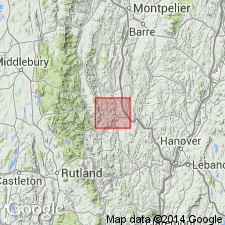
- Usage in publication:
-
- Barnard gneiss
- Modifications:
-
- Original reference
- Dominant lithology:
-
- Gneiss
- AAPG geologic province:
-
- New England province
Summary:
Pg. 91-92. Barnard gneiss. Acid intrusive gneiss forming continuous outcrop for several miles in Barnard Township, [Windsor County, southeastern Vermont]. Composes prominent ridge on west side of Locust Creek north of village of Barnard, but before it enters Bethel, on north, it forms prominent ridge on both sides of Locust Creek. Is light gray, tinged with green from presence of a little chlorite and epidote. Of gneissoid structure and medium to coarse grained texture. Exact age unknown. That it is pre-Ordovician seems certain, and it may be pre-Cambrian.
Source: US geologic names lexicon (USGS Bull. 896, p. 113).
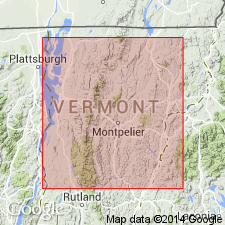
- Usage in publication:
-
- Barnard gneiss
- Modifications:
-
- Age modified
- AAPG geologic province:
-
- New England province
Summary:
Table opp. p. 288. Barnard gneiss. Assigned this formation to Upper Cambrian, but without discussion.
Source: US geologic names lexicon (USGS Bull. 896, p. 113).
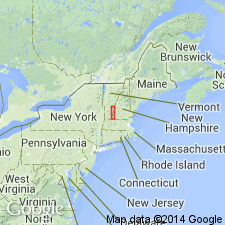
- Usage in publication:
-
- Barnard Volcanic Member*
- Modifications:
-
- Age modified
- Geochronologic dating
- AAPG geologic province:
-
- New England province
Summary:
New U-Pb zircon data indicate an age of 418+/-1 Ma (Silurian) for the Barnard Volcanic Member of Missisquoi Formation. Another sample, thought to be from Barnard, yielded an Early Cambrian age; this leads to one of two possibilities: either the rock was not actually from Barnard as was thought, or the zircons were detrital or xenocrystic in origin.
Source: GNU records (USGS DDS-6; Reston GNULEX).
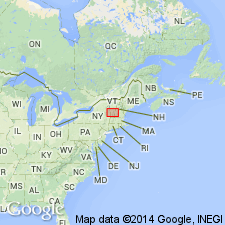
- Usage in publication:
-
- Barnard Volcanic Member*
- Modifications:
-
- Areal extent
- AAPG geologic province:
-
- New England province
Summary:
In Glens Falls quad, rocks of eastern Green Mountain terrane, east of Richardson Memorial Contact (an eastward-facing unconformity or possibly a tectonic contact) include the Hoosac, Pinney Hollow, Ottauquechee, and Stowe Formations (of probable Cambrian through Early Ordovician age), Moretown Formation (probably Ordovician), and Barnard Volcanic Member of Missisquoi Formation [unclear as to its stratigraphic position or age here]. West of Richardson Memorial Contact, rocks include conglomeratic units such as Tyson Formation as used by Doll and others (1961) [no age provided, but presumably Cambrian].
Source: GNU records (USGS DDS-6; Reston GNULEX).
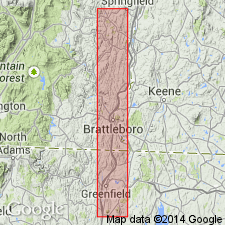
- Usage in publication:
-
- Barnard Gneiss
- Modifications:
-
- Geochronologic dating
- AAPG geologic province:
-
- New England province
Summary:
Isotopic age on zircons from Barnard Gneiss of 524+/-4 Ma (Cambrian) reported by Aleinikoff and Karabinos (1990) has been refined to 484+/-2 Ma (Early Ordovician) by Karabinos (personal commun., 1992). Barnard underlies the Ordovician and Silurian Hawley Formation.
Source: GNU records (USGS DDS-6; Reston GNULEX).
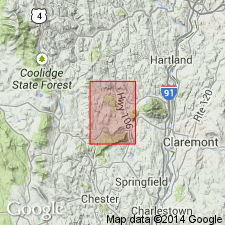
- Usage in publication:
-
- Barnard Gneiss*
- Modifications:
-
- Age modified
- AAPG geologic province:
-
- New England province
Summary:
The Barnard Gneiss consists of layered felsic and mafic gneiss. Unit is heterogeneous consisting of light-gray, magnetite-hornblende-biotite-plagioclase-quartz granofels, hornblende fascicle schist or dark-gray to greenish-gray-weathering, biotite-hornblende-plagioclase amphibolite. Passes laterally into rusty weathering amphibolite. Overlies rusty weathering sulfidic schist of the Moretown Formation. The age of the Barnard is Ordovician and Silurian. U-Pb age on zircon from felsic, probably youngest, nearly concordant intrusive phase of Barnard yields date of 418+/-1 Ma (Aleinikoff and Karabinos, 1990), which gives an upper age of probably Late Silurian. Elsewhere, Barnard contains zircon dated as old as Middle Ordovician or even Cambrian (Aleinikoff and Karabinos, 1990). Age is most probably Ordovician to Silurian.
Source: GNU records (USGS DDS-6; Reston GNULEX).
For more information, please contact Nancy Stamm, Geologic Names Committee Secretary.
Asterisk (*) indicates published by U.S. Geological Survey authors.
"No current usage" (†) implies that a name has been abandoned or has fallen into disuse. Former usage and, if known, replacement name given in parentheses ( ).
Slash (/) indicates name conflicts with nomenclatural guidelines (CSN, 1933; ACSN, 1961, 1970; NACSN, 1983, 2005, 2021). May be explained within brackets ([ ]).

